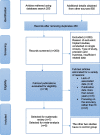The impact of digitization and conventional techniques on the fit of fixed partial dentures FPDs: systematic review and Meta-analysis
- PMID: 38049754
- PMCID: PMC10696807
- DOI: 10.1186/s12903-023-03628-1
The impact of digitization and conventional techniques on the fit of fixed partial dentures FPDs: systematic review and Meta-analysis
Abstract
Purpose of the study: The goal behind this study is to answer the question "In tooth-supported fixed partial dentures (FPDs), does the digital impression techniques compared to fabrications using conventional impression methods improve the marginal and internal fit?
Background: The incorporation of digital technology in the fabrication of fixed partial dentures (FPDs) has accelerated over the past decade. This study is directed at evaluating the marginal and internal fit of FPDs manufactured using digital approaches compared to conventional techniques. The need for updated data has encouraged this review.
Materials and methods: An electronic search was conducted in PubMed, Scopus, Web of Science, and the Grey Database to identify relevant studies. The Modified Methodological Index for Non-Randomized Studies (MINORS) was used to assess the risk of bias in in vitro experiments. The key results of this meta-analysis were the standard mean differences (SMDs) and 95% confidence intervals (CI) of each main variance, marginal fit, and internal fit between the digital and conventional techniques. Additional analyses were performed to assess the significance of three subgroup parameters: method of digitalization, cement spacer thickness, and span length, and their influence on the fit of the FPDs.
Results: Based on predefined criteria, of the seven articles included in this systematic review, only five were selected for the quantitative data analysis. The marginal fit results were (P = 0.06; SMD: -1.88; 95% CI: - 3.88, 0.11) (P > 0.05) and the internal fit results were (P = 0.02; SMD: -0.80; 95% CI: - 1.49, - 0.10) (P < 0.05). Regarding the subgroup analyses, the method of digitalization subgroup results were (P = 0.35; SMD: -1.89; 95% CI: - 3.89, 0.11) and (P = 0.80; SMD: -0.80; 95% CI: - 1.49, - 0.11) for marginal and internal fit, respectively. The span length results were (P = 0.10; SMD: -1.89; 95% CI: - 3.89, 0.11) for marginal fit and (P = 0.02; SMD: -0.80; 95% CI: - 1.49, - 0.11) for internal fit. The cement spacer thickness (P = 0.01; SMD: -1.89; 95% CI: - 3.89, 0.11) and (P = 0.04; SMD: -0.80; 95% CI: - 1.49, - 0.11) for marginal and internal fit, respectively.
Conclusion: Tooth-retained fixed partial dentures FPDs produced by digital scanning and computer-aided design/computer-aided manufacturing (CAD/CAM) systems can significantly enhance the internal fit compared with those manufactured by traditional methods. Intraoral scanners can replace conventional impressions for the fabrication of FPDs because they minimize the operating time and reduce patient pain. Further clinical studies are required to obtain more conclusive results.
Systematic review registration: This systematic review and meta-analysis was registered in the International Prospective Register of Systematic Reviews (PROSPERO), registration number CRD42021261397.
Keywords: Digital techniques; Fixed partial dentures; Internal fit; Marginal fit; Meta-analysis.
© 2023. The Author(s).
Conflict of interest statement
The authors declare no competing interests.
Figures















References
-
- Keshvad A, Hooshmand T, Asefzadeh F, Khalilinejad F, Alihemmati M, Van Noort R. Marginal gap, internal fit, and fracture load of leucite-reinforced ceramic inlays fabricated by CEREC inLab and hot-pressed techniques. J Prosthodont. 2011;20(7):535–540. doi: 10.1111/j.1532-849X.2011.00745.x. - DOI - PubMed
-
- Abdel-Azim T, Rogers K, Elathamna E, Zandinejad A, Metz M, Morton D. Comparison of the marginal fit of lithium disilicate crowns fabricated with CAD/CAM technology by using conventional impressions and two intraoral digital scanners. J Prosthet Dent. 2015;114(4):554–559. doi: 10.1016/j.prosdent.2015.04.001. - DOI - PubMed
Publication types
MeSH terms
LinkOut - more resources
Full Text Sources
Research Materials
Miscellaneous

